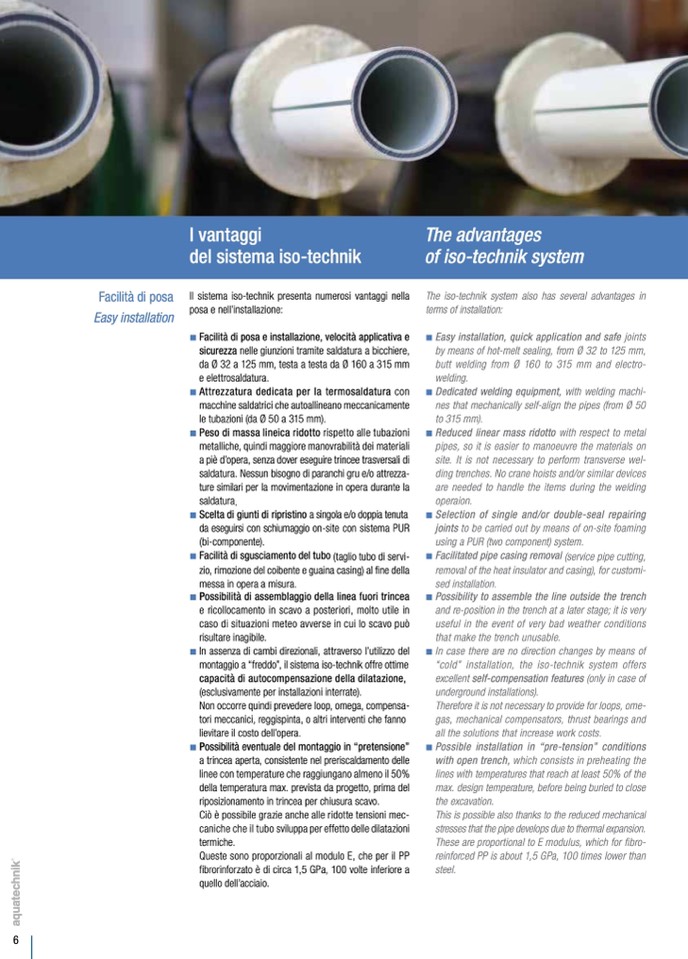
Raccorderia Fittings
I vantaggi
The advantages
del sistema iso-technik
of iso-technik system
Facilità di posa
Easy installation
Il sistema iso-technik presenta numerosi vantaggi nella
posa e nell’installazione:
nFacilità di posa e installazione, velocità applicativa e
sicurezza nelle giunzioni tramite saldatura a bicchiere,
da Ø 32 a 125 mm, testa a testa da Ø 160 a 315 mm
e elettrosaldatura.
nAttrezzatura dedicata per la termosaldatura con
macchine saldatrici che autoallineano meccanicamente
le tubazioni (da Ø 50 a 315 mm).
nPeso di massa lineica ridotto rispetto alle tubazioni
metalliche, quindi maggiore manovrabilità dei materiali
a piè d’opera, senza dover eseguire trincee trasversali di
saldatura. Nessun bisogno di paranchi gru e/o attrezza-
ture similari per la movimentazione in opera durante la
saldatura.
n Scelta di giunti di ripristino a singola e/o doppia tenuta
da eseguirsi con schiumaggio on-site con sistema PUR
(bi-componente).
nFacilità di sgusciamento del tubo (taglio tubo di servi-
zio, rimozione del coibente e guaina casing) al fine della
messa in opera a misura.
nPossibilità di assemblaggio della linea fuori trincea
e ricollocamento in scavo a posteriori, molto utile in
caso di situazioni meteo avverse in cui lo scavo può
risultare inagibile.
nIn assenza di cambi direzionali, attraverso l’utilizzo del
montaggio a “freddo”, il sistema iso-technik offre ottime
capacità di autocompensazione della dilatazione,
(esclusivamente per installazioni interrate).
Non occorre quindi prevedere loop, omega, compensa-
tori meccanici, reggispinta, o altri interventi che fanno
lievitare il costo dell’opera.
nPossibilità eventuale del montaggio in “pretensione”
a trincea aperta, consistente nel preriscaldamento delle
linee con temperature che raggiungano almeno il 50%
della temperatura max. prevista da progetto, prima del
riposizionamento in trincea per chiusura scavo.
Ciò è possibile grazie anche alle ridotte tensioni mec-
caniche che il tubo sviluppa per effetto delle dilatazioni
termiche.
Queste sono proporzionali al modulo E, che per il PP
fibrorinforzato è di circa 1,5 GPa, 100 volte inferiore a
quello dell’acciaio.
The iso-technik system also has several advantages in
terms of installation:
nEasy installation, quick application and safe joints
by means of hot-melt sealing, from Ø 32 to 125 mm,
butt welding from Ø 160 to 315 mm and electro-
welding.
nDedicated welding equipment, with welding machi-
nes that mechanically self-align the pipes (from Ø 50
to 315 mm).
nReduced linear mass ridotto with respect to metal
pipes, so it is easier to manoeuvre the materials on
site. It is not necessary to perform transverse wel-
ding trenches. No crane hoists and/or similar devices
are needed to handle the items during the welding
operaion.
n Selection of single and/or double-seal repairing
joints to be carried out by means of on-site foaming
using a PUR (two component) system.
nFacilitated pipe casing removal (service pipe cutting,
removal of the heat insulator and casing), for customi-
sed installation.
nPossibility to assemble the line outside the trench
and re-position in the trench at a later stage; it is very
useful in the event of very bad weather conditions
that make the trench unusable.
nIn case there are no direction changes by means of
“cold” installation, the iso-technik system offers
excellent self-compensation features (only in case of
underground installations).
Therefore it is not necessary to provide for loops, ome-
gas, mechanical compensators, thrust bearings and
all the solutions that increase work costs.
nPossible installation in “pre-tension” conditions
with open trench, which consists in preheating the
lines with temperatures that reach at least 50% of the
max. design temperature, before being buried to close
the excavation.
This is possible also thanks to the reduced mechanical
stresses that the pipe develops due to thermal expansion.
These are proportional to E modulus, which for fibro-
reinforced PP is about 1,5 GPa, 100 times lower than
steel.
6

